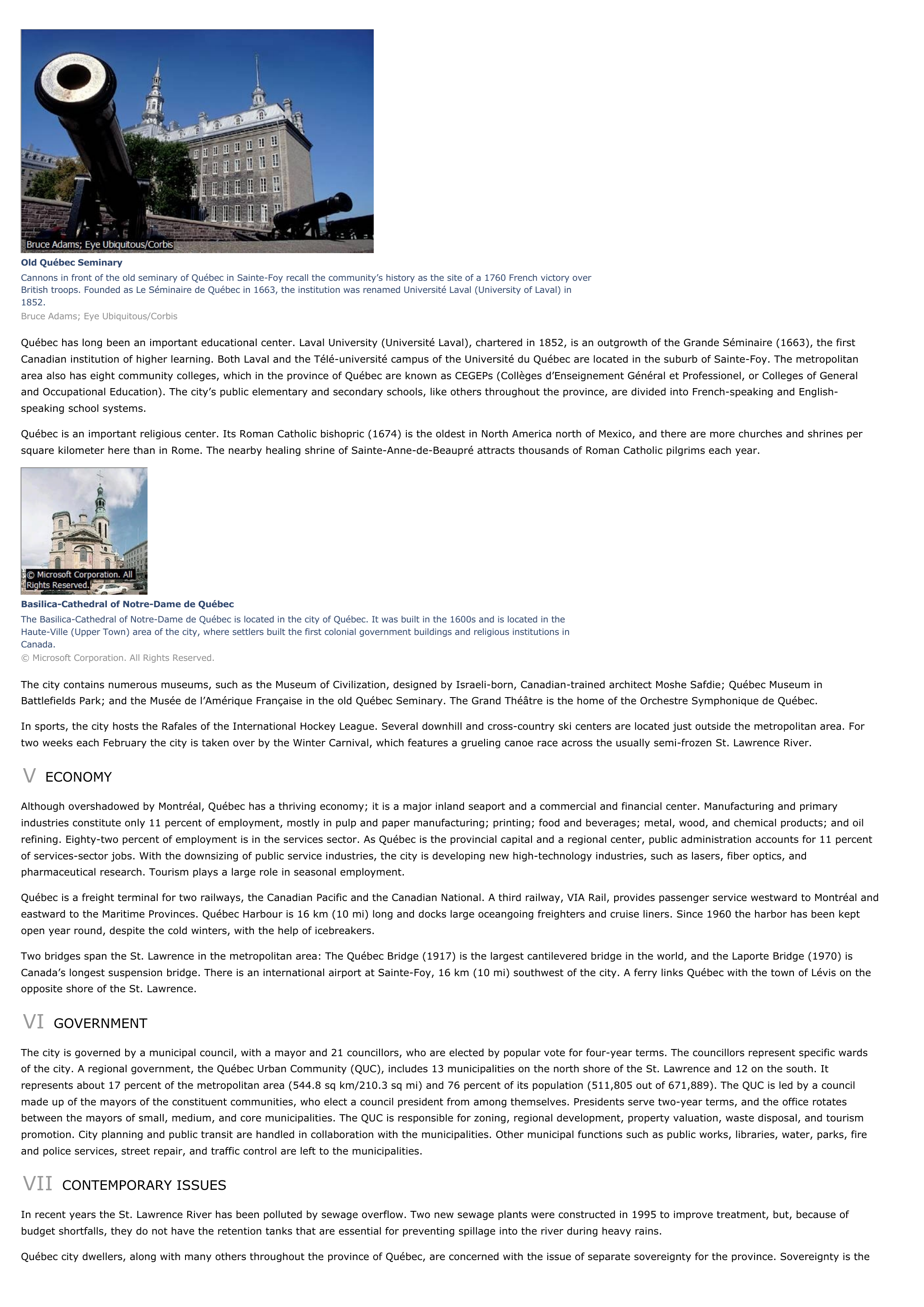Québec (city) - geography.
Publié le 26/05/2013

Extrait du document
«
Old Québec SeminaryCannons in front of the old seminary of Québec in Sainte-Foy recall the community’s history as the site of a 1760 French victory overBritish troops.
Founded as Le Séminaire de Québec in 1663, the institution was renamed Université Laval (University of Laval) in1852.Bruce Adams; Eye Ubiquitous/Corbis
Québec has long been an important educational center.
Laval University (Université Laval), chartered in 1852, is an outgrowth of the Grande Séminaire (1663), the firstCanadian institution of higher learning.
Both Laval and the Télé-université campus of the Université du Québec are located in the suburb of Sainte-Foy.
The metropolitanarea also has eight community colleges, which in the province of Québec are known as CEGEPs (Collèges d’Enseignement Général et Professionel, or Colleges of Generaland Occupational Education).
The city’s public elementary and secondary schools, like others throughout the province, are divided into French-speaking and English-speaking school systems.
Québec is an important religious center.
Its Roman Catholic bishopric (1674) is the oldest in North America north of Mexico, and there are more churches and shrines persquare kilometer here than in Rome.
The nearby healing shrine of Sainte-Anne-de-Beaupré attracts thousands of Roman Catholic pilgrims each year.
Basilica-Cathedral of Notre-Dame de QuébecThe Basilica-Cathedral of Notre-Dame de Québec is located in the city of Québec.
It was built in the 1600s and is located in theHaute-Ville (Upper Town) area of the city, where settlers built the first colonial government buildings and religious institutions inCanada.© Microsoft Corporation.
All Rights Reserved.
The city contains numerous museums, such as the Museum of Civilization, designed by Israeli-born, Canadian-trained architect Moshe Safdie; Québec Museum inBattlefields Park; and the Musée de l’Amérique Française in the old Québec Seminary.
The Grand Théâtre is the home of the Orchestre Symphonique de Québec.
In sports, the city hosts the Rafales of the International Hockey League.
Several downhill and cross-country ski centers are located just outside the metropolitan area.
Fortwo weeks each February the city is taken over by the Winter Carnival, which features a grueling canoe race across the usually semi-frozen St.
Lawrence River.
V ECONOMY
Although overshadowed by Montréal, Québec has a thriving economy; it is a major inland seaport and a commercial and financial center.
Manufacturing and primaryindustries constitute only 11 percent of employment, mostly in pulp and paper manufacturing; printing; food and beverages; metal, wood, and chemical products; and oilrefining.
Eighty-two percent of employment is in the services sector.
As Québec is the provincial capital and a regional center, public administration accounts for 11 percentof services-sector jobs.
With the downsizing of public service industries, the city is developing new high-technology industries, such as lasers, fiber optics, andpharmaceutical research.
Tourism plays a large role in seasonal employment.
Québec is a freight terminal for two railways, the Canadian Pacific and the Canadian National.
A third railway, VIA Rail, provides passenger service westward to Montréal andeastward to the Maritime Provinces.
Québec Harbour is 16 km (10 mi) long and docks large oceangoing freighters and cruise liners.
Since 1960 the harbor has been keptopen year round, despite the cold winters, with the help of icebreakers.
Two bridges span the St.
Lawrence in the metropolitan area: The Québec Bridge (1917) is the largest cantilevered bridge in the world, and the Laporte Bridge (1970) isCanada’s longest suspension bridge.
There is an international airport at Sainte-Foy, 16 km (10 mi) southwest of the city.
A ferry links Québec with the town of Lévis on theopposite shore of the St.
Lawrence.
VI GOVERNMENT
The city is governed by a municipal council, with a mayor and 21 councillors, who are elected by popular vote for four-year terms.
The councillors represent specific wardsof the city.
A regional government, the Québec Urban Community (QUC), includes 13 municipalities on the north shore of the St.
Lawrence and 12 on the south.
Itrepresents about 17 percent of the metropolitan area (544.8 sq km/210.3 sq mi) and 76 percent of its population (511,805 out of 671,889).
The QUC is led by a councilmade up of the mayors of the constituent communities, who elect a council president from among themselves.
Presidents serve two-year terms, and the office rotatesbetween the mayors of small, medium, and core municipalities.
The QUC is responsible for zoning, regional development, property valuation, waste disposal, and tourismpromotion.
City planning and public transit are handled in collaboration with the municipalities.
Other municipal functions such as public works, libraries, water, parks, fireand police services, street repair, and traffic control are left to the municipalities.
VII CONTEMPORARY ISSUES
In recent years the St.
Lawrence River has been polluted by sewage overflow.
Two new sewage plants were constructed in 1995 to improve treatment, but, because ofbudget shortfalls, they do not have the retention tanks that are essential for preventing spillage into the river during heavy rains.
Québec city dwellers, along with many others throughout the province of Québec, are concerned with the issue of separate sovereignty for the province.
Sovereignty is the.
»
↓↓↓ APERÇU DU DOCUMENT ↓↓↓
Liens utiles
- Québec (city) - Geography.
- Buenos Aires (city) - geography.
- Dublin (city, Ireland) - geography.
- Mexico City - geography.
- Moscow (city, Russia) - geography.

































